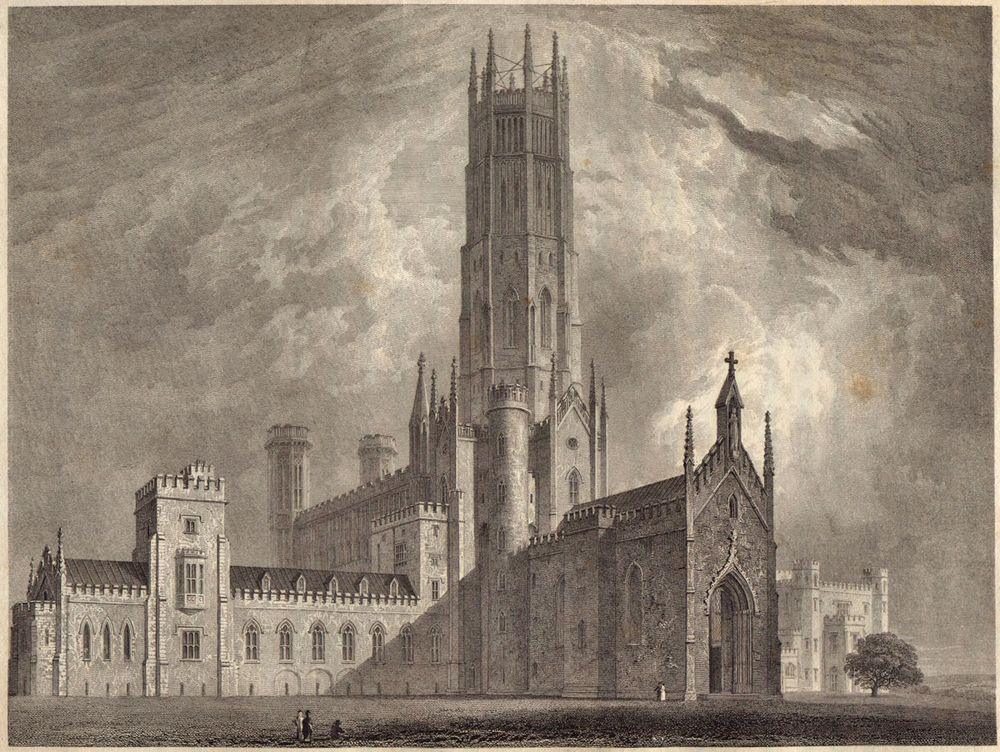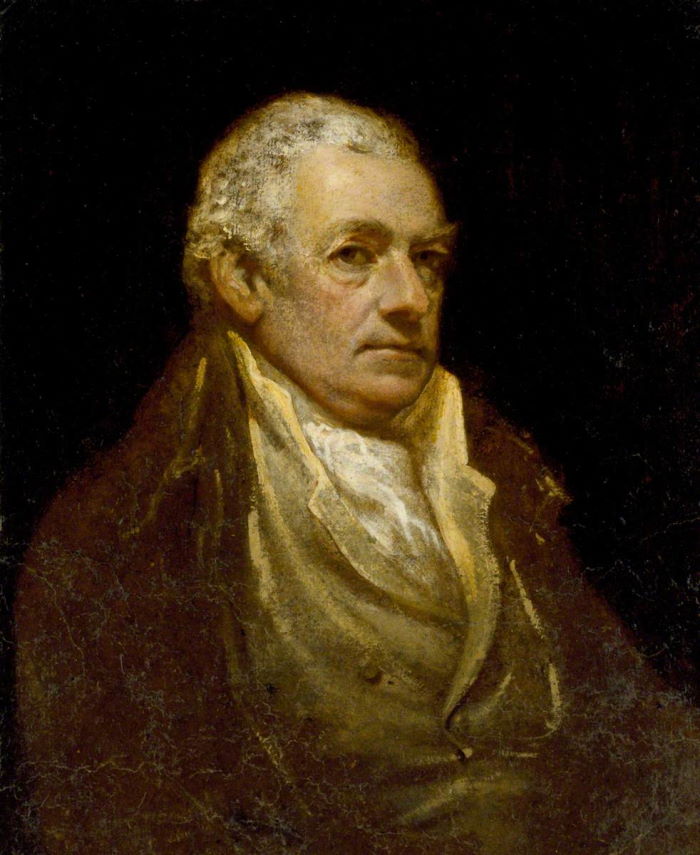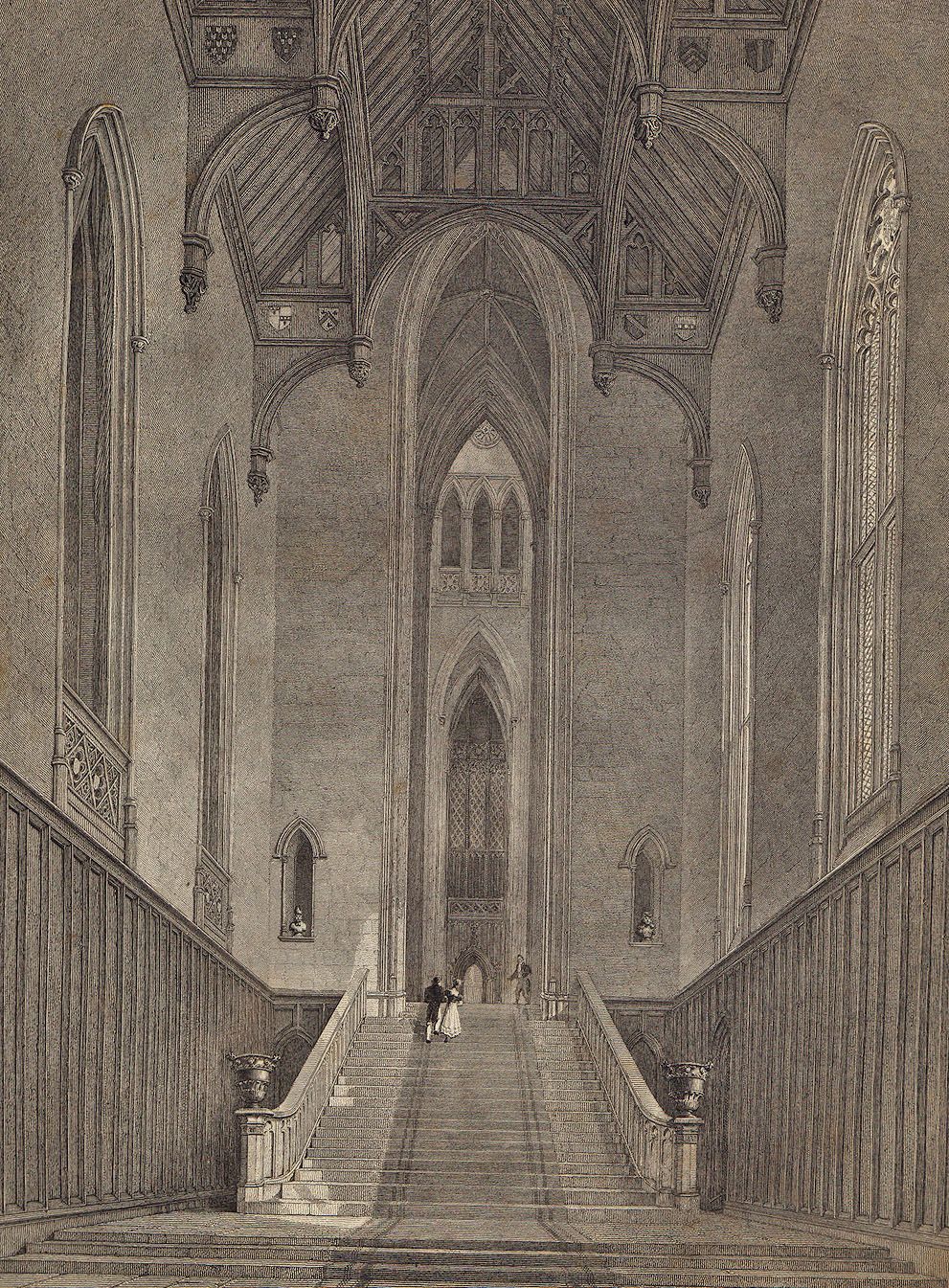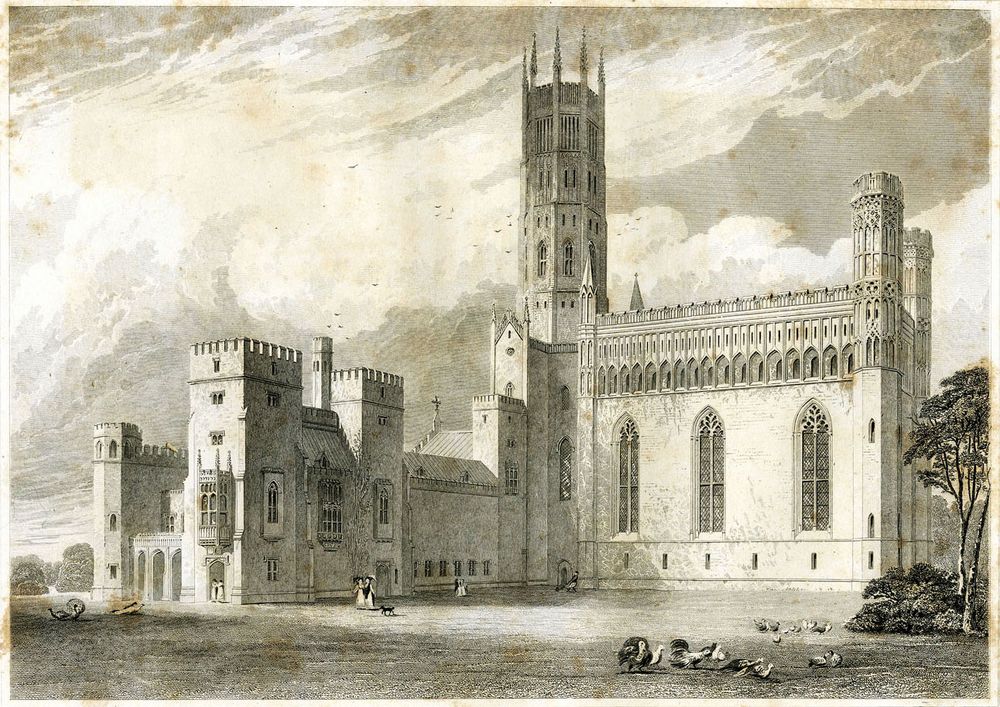At Fonthill Gifford in Wiltshire, England, where now stands a small four-story tower with an attached two-story wing, there once stood one of the most extraordinary houses ever built. The Fonthill Abbey was a house built at a fantastic scale. The central tower rose to a dizzying height of 280 feet, the tallest ever put on a private house. The front doors were 30 feet high and windows were taller still at 50 feet. The curtains that hung from the four arches in the central room were 80 feet long. Staircases were as wide as they were long, and the view down the central corridor stretched for over three hundred feet.

Fonthill Abbey. Photo: Wikimedia Commons
Equally fascinating were the men who were behind this creation—owner William Beckford and architect James Wyatt.
William Beckford was fabulously rich, thanks to his wealthy father who owned plantations all across Jamaica and whose family dominated the West Indian sugar trade for a hundred years. At the age of ten, he inherited £1 million that afforded him an income of £100,000 per annum, a colossal sum at the time. His doting mother made sure the young Beckford enjoyed every advantage wealth could provide. She arranged for Wolfgang Mozart, then only eight years old, to give him piano lessons. Sir William Chambers, the king’s architect, taught him to draw. Lord Byron called him ‘England’s wealthiest son’.
In 1784, at the age of twenty-four, Beckford became involved in two scandalous affairs—one with Louisa Beckford, the wife of his first cousin, and another with a handsome youth named William Courtenay, the future ninth Earl of Devon, who was eight years younger. Beckford’s affair with William went back by several years, at least, and William could have been as young as ten when he fell prey to Beckford’s sordid ways. Apparently, Beckford carried both relationships simultaneously, often under the same roof, until the autumn of 1784, when Beckford discovered that William had a lover of his own. Brewing with rage, Beckford stormed into William’s room, and according to the testimony of a houseguest, “horsewhipped him, which created a noise, and the door being opened, Courtenay was discovered in his shirt, and Beckford in some posture or other”.

William Beckford.
The scandal ruined Beckford’s reputation, and he fled the country. He travelled widely, and shortly after wrote his best-known work, a French gothic novel called Vathek, which he boasted took only three days and two nights to write. Beckford wrote several other books during his career as a novelist—Dreams, Waking Thoughts and Incidents (1783), Memoirs of Extraordinary Painters (1780), and Letters from Italy with Sketches of Spain and Portugal (1834). However, Beckford’s fame rested not upon his literary efforts but rather upon his eccentric extravagances as a builder and collector.
In 1796, Beckford returned to England and engaged architect James Wyatt to design for him a sensational house, the disproportionately large mansion Fonthill Abbey.
James Wyatt was an architect of considerable repute. The son of a farmer, Wyatt was drawn to architecture as a young man and spent six years in Italy studying architectural drawing. While working as an architectural draughtsman and painter under the Italian painter Antonio Visentini, Wyatt once made measured drawings of the dome of St. Peter's Basilica while lying on his back on a ladder slung horizontally, without cradle or side-rail, 300 feet up in the air. In 1770, at the age of twenty-four, he designed the ‘Pantheon’, an exhibition hall and assembly room in London loosely modelled on the ancient building of the same name in Rome. When the Pantheon was opened in 1772, writer and historian Horace Walpole pronounced it to be “the most beautiful edifice in England.”

James Wyatt
James Wyatt, however, was a mess of a human being. He was disorganized, forgetful and alcoholic. One year he missed fifty straight weekly meetings at the Office of Works as the Surveyor General. His supervision of the office was so poor that one man was discovered to have been on holiday for three years.
Despite his shortcomings, James Wyatt was a very popular and sought-after architect who seldom said no to a client. As a result, he always had more commissions than he could manage, which left him with little time to give proper attention to the individual needs of his clients. William Beckford would learn that the hard way.
Construction of the Fonthill abbey began in earnest in 1796 on Beckford's estate of Fonthill Gifford. But due to Wyatt's constant absences from the site, Beckford often found himself taking the roles of construction site supervisor, general organizer, and patron.
Beckford hired 500 laborers to work day and night. Later, he brought 450 more from the building of the new royal apartments at Windsor Castle wooing them with increased ration of ale. He also commandeered all the local wagons for transportation of building materials. To compensate, Beckford delivered free coal and blankets to the poor in cold weather.

The hall of Fonthill Abbey. Photo: Wikimedia Commons
On Beckford’s request, Wyatt designed the mansion in the scale of superlatives. The house was more than three hundred feet long, occupied by a north to south running corridor, the entire length of which is visible from one end to the other. At the center stood an octagonal tower 280 feet tall. The tower was so tall that it collapsed during construction, twice. Once he told his workers to hurry so that food could be prepared in the new kitchen. The kitchen collapsed as soon as the meal was over.
Despite its grandness, the interior was surprisingly dark and gloomy. The central corridor was unheated for most of its length and was illuminated by just a few candles at night. Most of the bedrooms were as bare as monastic cells, and thirteen of them had no windows. Beckford’s own bedchamber contained a single narrow bed.
Beckford lived alone in this colossal mansion, and he dined alone in a 50-feet-long table. Yet, his kitchens prepared food for 12 every day. The surplus food was sent away afterwards. Only once, in 1800, did he entertain guests, when Horatio Nelson and Emma Hamilton visited the abbey for Christmas. To preserve his lonely existence, Beckford built a formidable wall, known as The Barrier, around the estate. It was twelve feet high, twelve miles long, and surmounted by iron spikes.

Photo: Architectural Association Collection
Beckford lived in Fonthill Abbey until 1822 when he lost two of his Jamaican sugar plantations which put him in debit, forcing him to sell the Abbey and its contents for £330,000. Three years later, in 1825, the Abbey’s tower collapsed for one final time. The house was never repaired.
Beckford retired to Bath, where he commissioned local architect H E Goodridge to build him a new 154-feet tower overlooking the city. Unlike Fonthill Abbey, this tower, called Lansdown Tower (or Beckford’s Tower), still stands.

Beckford's Tower in Bath. Photo: Michael Day/Flickr

The ruins of Fonthill Abbey today. Photo: Rictor Norton & David Allen/Flickr
References:
# www.fonthill.co.uk/history
# Wikipedia
# Bill Bryson, At Home: A short history of private life



Comments
Post a Comment